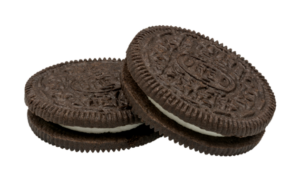If you’ve ever eaten an Oreo, you’ve probably noticed how hard it was to eat just one.
Don’t worry, it’s not just you! Research has found that Oreos are more addictive than cocaine.[1]
A big reason for that is the fact that the cookies are loaded with the artificial sweetener high-fructose corn syrup (HFCS).
A Canadian study found that HFCS can cause behavioral reactions similar to those produced by common street drugs.[2] Other research shows that HFCS and cocaine stimulate the same brain circuits.
I know what you’re probably thinking… What does all this have to do with hot flashes?

Let me explain.
As you probably know, HFCS is in a lot of foods that make up the standard American diet. It’s a big part of the reason we have an obesity epidemic in our country.
But HFCS does more than make you ga
in weight. It also causes fat to build up in your liver.When that happens, you can end up with a condition called fatty liver disease.
Over the last 10 to 15 years, I’ve seen a sharp increase in the number of patients with fatty liver disease at my clinic – in both men and women.
But for women, the symptoms of fatty liver disease can look a lot like menopause. Symptoms like night sweats, exhaustion, extra weight around the abdomen… and hot flashes.
That’s why so many mainstream doctors miss this diagnosis. They write the symptoms off as “women’s problems.”
The truth is, you could have fatty liver disease and not even know it.
Liver diseases are one of the fastest-growing health epidemics in the world.
According to a new study, today up to 50% of Americans suffer from nonalcoholic liver disease (NAFLD) – including children as young as 2 years old.[3]
And HFCS is a big contributor.
You see, HFCS isn’t like other sugars. Most of it goes straight to your liver instead of going into your muscles and tissues for energy. It promotes the formation of new fat molecules. It triggers your liver cells to store this fat where it doesn’t belong. At the same time, it blocks the breakdown of old fats.
A study from the University of Florida found patients with fatty liver disease ate two to three times more high fructose corn syrup.[4] And just like alcohol, this cheap fructose is addictive. Once you start eating it, you crave even more sweets.
Corn syrup floods your bloodstream, overwhelming your liver’s processing capacity. Your liver becomes inflamed and develops into NAFLD.
3 Simple Tips To Improve Your Liver Health
Mainstream medicine has no treatments for this condition. However, I help my patients treat fatty liver disease with three simple, natural solutions.
- Supplement with DHA. Researchers found that supplementing with the omega-3 fatty acid DHA stops fatty liver disease in its tracks. In the study, they fed animals a Western-style diet that leads to obesity. Then they gave them DHA. The team found that DHA blocked the progression of the worst form of fatty liver disease – even though the animals continued to eat the same dangerous diet.[5] In a human study, volunteers taking 1,000 mg per day of omega-3s decreased serum markers of liver cell damage and levels of triglyceride fats.[6] You see, DHA is anti-inflammatory. It helps to heal liver cell membranes. DHA also suppresses the production of new liver fat cells and stimulates the burning of fat cells. You can get DHA from grass-fed meats and organs. But it’s almost impossible to get enough from your diet. I advise my patients to supplement with between 600 mg and 1,000 of DHA daily from a combination of squid oil and krill oil.
- Take the liver herb. Milk thistle is also known as the “liver herb.” It has an active compound called silymarin. In a placebo-controlled study of 100 patients, silymarin promoted a significant decline in liver enzyme markers. That indicated a reversal of NAFLD with no serious side effects.[7]
- Use my favorite supplement. A study in the Journal of the American College of Nutrition proved that CoQ10 can also treat NAFLD.[8] The trial included 41 people with mild to moderate NAFLD. Researchers gave half the patients 100 mg of CoQ10 every day. The other half got a placebo. After 12 weeks, all signs of NAFLD were lower in the CoQ10 group. Four of the patients on CoQ10 even returned to normal liver function.
You can get CoQ10 from grass-fed organ meat and beef, game, and wild-caught fatty fish. But again, it’s hard to get all you need from diet alone. Normally, I recommend 50 mg daily. But to treat NAFLD, I suggest taking 100 to 300 mg per day of the ubiquinol form of CoQ10. Divide it into two doses.
[1] Connecticut College News, October 15, 2013
[2] Addiction to unhealthy foods could help explain the global obesity epidemic. EurekAlert!
[3] Cha A. “Fatty liver disease was a disease of the old. Then kids started getting sick.” https://www.washingtonpost.com/health/interactive/2023/nonalcoholic-fatty-liver-disease-kids/.
[4] Lyssoiotis C, Cantley. “F stands for fructose and fat.” Nature. 2013;502:181-182.
[5] https://synergies.oregonstate.edu/2017/dha-offers-hope-to-stop-deadly-march-toward-cirrhosis-liver-cancer/
[6] Capanni M, et al. “Prolonged n-3 polyunsaturated fatty acid supplementation ameliorates hepatic steatosis in patients with nonalcoholic fatty liver disease: a pilot study.” Aliment Pharmacol Ther. 2006 Apr 15;23(8):1143-51.
[7] Hashemi et al. “A placebo-controlled trial of silymarin in patients with nonalcoholic fatty liver disease.” Hepatitis Monthly. 2011;9(4):265-270.
[8] Farnaz Farsi et al. “Functions of Coenzyme Q10 Supplementation on liver enzymes, markers of systemic inflammation, and adipokines in patients affected by nonalcoholic fatty liver disease: A double-blind, placebo-controlled, randomized clinical trial.” J Am Coll Nutr. 2016;35(4):346-353
